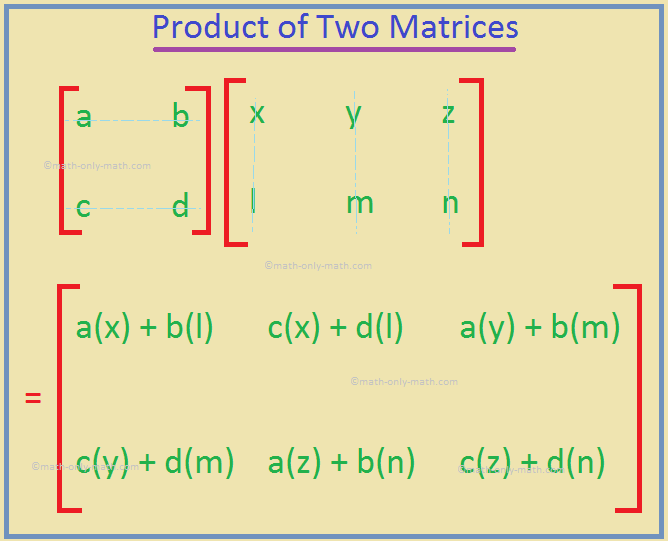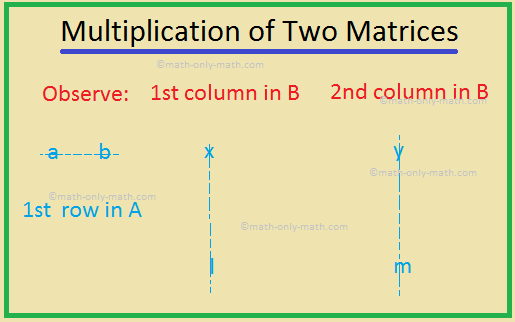Subscribe to our ▶️ YouTube channel 🔴 for the latest videos, updates, and tips.
Multiplication of Two Matrices
Here we will learn the process of Multiplication of two matrices.
Two matrices A and B are conformable (compatible) for multiplication
(i) AB if the number of columns in A = the number of rows in B
(ii) BA if the number of columns in B = the number of rows in A.
To find the product AB when A and B are conformable for multiplication AB
Let A = \(\begin{bmatrix} a & b\\ c & d \end{bmatrix}\) and B = \(\begin{bmatrix} x & y & z\\ l & m & n \end{bmatrix}\)
A is a 2 × 2 matrix and B is a 2 × 3 matrix.
Therefore, the number of columns in A = the number of rows in B = 2.
Therefore, AB can be found because A, B are conformable for multiplication AB.
The product AB is defined as
AB = \(\begin{bmatrix} a & b\\ c & d \end{bmatrix}\) \(\begin{bmatrix} x & y & z\\ l & m & n \end{bmatrix}\)
= \(\begin{bmatrix} a(x) + b(l) & a(y) + b(m) & a(z) + b(n)\\c(x) +d(l) & c(y) + d(m) & c(z) + d(n) \end{bmatrix}\)
Clearly, the product BA is not possible because the number of columns in B(=3) ≠ the number of rows in A(=2).
Note: Given two matrices A and B, AB may be found but BA may not be found. It is also possible that neither AB nor BA can be found, or both AB and BA can be found.
Solved Example on Multiplication of Two Matrices:
1. Let A = \(\begin{bmatrix} 2 & 5\\ -1 & 3 \end{bmatrix}\) and B = \(\begin{bmatrix} 2 & 5\\ -1 & 3 \end{bmatrix}\). Find AB and BA. Is AB = BA?
Solution:
Here, A is of the order 2 × 2 and B is of the order 2 × 2.
So, the number of columns in A = the number of rows in B. Hence, AB can be found. Also, the number of columns in B = the number of rows in A. Hence, BA can also found.
Now,
AB = \(\begin{bmatrix} 2 & 5\\ -1 & 3 \end{bmatrix}\) \(\begin{bmatrix} 2 & 5\\ -1 & 3 \end{bmatrix}\)
= \(\begin{bmatrix} 2 × 1 + 5 × 4 & 2 × 1 + 5 × (-2)\\ (-1) × 1 + 3 × 4 & (-1) × 1 + 3 × (-2) \end{bmatrix}\)
= \(\begin{bmatrix} 22 & -8\\ 11 & -7 \end{bmatrix}\)
BA = \(\begin{bmatrix} 2 & 5\\ -1 & 3 \end{bmatrix}\) \(\begin{bmatrix} 2 & 5\\ -1 & 3 \end{bmatrix}\)
= \(\begin{bmatrix} 1 × 2 + 1 × (-1) & 1 × 5 + 1 × 3\\ 4 × 2 + (-2) × (-1) & 4 × 5 + (-2) × 3 \end{bmatrix}\)
= \(\begin{bmatrix} 1 & 8\\ 10 & 14 \end{bmatrix}\).
Clearly, \(\begin{bmatrix} 22 & -8\\ 11 & -7 \end{bmatrix}\) ≠ \(\begin{bmatrix} 1 & 8\\ 10 & 14 \end{bmatrix}\).
Therefore, AB ≠ BA.
2. Let X = \(\begin{bmatrix} 11 & 4\\ -5 & 2 \end{bmatrix}\) and I = \(\begin{bmatrix} 1 & 0\\ 0 & 1 \end{bmatrix}\). Prove that XI = IX = A.
Solution:
XI = \(\begin{bmatrix} 11 & 4\\ -5 & 2 \end{bmatrix}\) \(\begin{bmatrix} 1 & 0\\ 0 & 1 \end{bmatrix}\)
= \(\begin{bmatrix} 11 × 1 + 4 × 0 & 11 × 0 + 4 × 1\\ -5 × 1 + 2 × 0 & -5 × 0 + 2 × 1 \end{bmatrix}\)
= \(\begin{bmatrix} 11 & 4\\ -5 & 2 \end{bmatrix}\) = X
IX = \(\begin{bmatrix} 1 & 0\\ 0 & 1 \end{bmatrix}\)\(\begin{bmatrix} 11 & 4\\ -5 & 2 \end{bmatrix}\)
= \(\begin{bmatrix} 1 × 11 + 0 × (-5) & 1 × 4 + 0 × 2\\ 0 × 11 + 1 × (-5) & 0 × 4 + 1 × 2 \end{bmatrix}\)
= \(\begin{bmatrix} 11 & 4\\ -5 & 2 \end{bmatrix}\) = X
Therefore, AI = IA =A. (Proved)
From Multiplication of Two Matrices to HOME PAGE
Didn't find what you were looking for? Or want to know more information about Math Only Math. Use this Google Search to find what you need.




New! Comments
Have your say about what you just read! Leave me a comment in the box below. Ask a Question or Answer a Question.